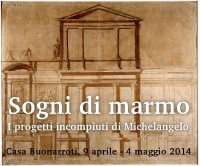By Allison Boyd (Lorenzo de’ Medici)
This exhibition was curated by members of the current Marist-Italy Masters of Museum Studies class, in conjunction with Istituto Lorenzo de’Medici and the Fondazione Casa Buonarroti, and is open until May 4.
The Casa Buonarroti museum, located at Via Ghibellina 70, is currently hosting a special exhibition titled Dreams of Marble: The unfinished works of Michelangelo. The exhibition focuses on the Tomb of Pope Julius II, in Rome, and the façade of the Basilica di San Lorenzo in Florence, both of which were considered to be, in some way, “incomplete”, as well as the demands and difficulties encountered by an artist of Michelangelo’s stature during the Renaissance. Through sketches and architectural designs, as well as documents and contracts, visitors can trace the path of Michelangelo’s creative process on these two projects, while understanding the parts of their development that was out of his hands.
The Tomb of Pope Julius II, once called the “great tragedy” of Michelangelo’s life, was originally conceived as a grand monument to the Pope, and was to be placed in St. Peter’s Basilica in the Vatican. Instead, after 40 years, many revisions of the design, and decreases in scale, a monument to Pope Julius II was erected in the Church of San Pietro in Vincoli. While the façade of the Basilica of San Lorenzo only took up a few years of Michelangelo’s life, those three years were also filled with frustration and ended with an incomplete project. The timeline of these two projects overlapped, with Michelangelo abandoning his work on the Tomb of Pope Julius II in 1517 to begin work on the San Lorenzo façade, and because of this overlap visitors can observe echoes of one project in the sketches and design elements of the other.
The exhibition room is introduced through detailed wall panels, four original documents, including instructions from Michelangelo to the stonemasons at Carrara and a contract between Michelangelo and the heirs of Pope Julius the II, and a quotation from Michelangelo’s writing. One wall contains sketches of the various incarnations of the design for the Tomb of Pope Julius the II, while the opposite wall contains plans for the façade of the Basilica of San Lorenzo. A recto verso sketch that has plans for San Lorenzo on one side and a figure drawing for the Julius II tomb on the other, links these two walls and clearly illustrates the overlap between these two projects.
There are didactic activities for high school students, families, and visitors with intellectual disabilities. All texts, with the exception of the original documents, are in English and Italian.
For more information please visit the website: http://www.casabuonarroti.it/it/2014/04/19/sogni-di-marmo-i-progetti-incompiuti-di-michelangelo/
Sogni di marmo: I progetti incompiuti di Michelangelo
Allison Boyd (Lorenzo de’ Medici)
La mostra, curata dagli studenti dell’attuale master Marist-Italia in Museum studies, con l’aiuto dell’Istituto Lorenzo de’ Medici e della Fondazione Casa Buonarroti, rimarrà aperta fino al 4 maggio e si concentra sia su due opere di Michelangelo rimaste incompiute – la tomba di Giulio II a Roma e la facciata della basilica di San Lorenzo a Firenze – che sulle difficoltà incontrate da un artista della sua statura durante il Rinascimento. Attraverso schizzi, disegni, documenti e contratti il visitatore può ripercorrere il processo creativo che ha portato l’artista allo sviluppo di questi due progetti.
La tomba di Giulio II, una volta chiamata la “grande tragedia” della vita di Michelangelo, fu originariamente concepita come un grande monumento al Papa e doveva essere eretta nella chiesa di San Pietro in Vaticano. Invece, dopo quaranta anni e molte revisioni nella struttura e nella scala, il monumento venne realizzato nella chiesa di San Pietro in Vincoli.
La facciata della chiesa di San Lorenzo impegnò Michelangelo solo per tre anni, pieni di frustrazioni, che diedero alla luce un progetto incompleto.
Le due opere si sovrapposero nel tempo e Michelangelo, nel 1571, abbandonò il progetto per la tomba di Giulio II per dedicarsi a quello fiorentino; i visitatori possono osservare gli echi di un progetto negli schizzi dell’altro.
L’esposizione è introdotta attraverso dettagliati pannelli esplicativi, quattro documenti originali – incluso quello con le istruzioni di Michelangelo ai cavatori di marmo di Carrara e un contratto tra Michelangelo e Giulio II – e una citazione dagli scritti del maestro.
Nella sala una parete è dedicata interamente alla vicenda della tomba di Giulio II mentre quella opposta al progetto per la facciata di San Lorenzo.
Un documento che presenta due diversi disegni sia sul verso che sul recto – uno relativo alla tomba del papa e uno alla chiesa fiorentina – unisce i temi delle le due pareti e illustra chiaramente come questi due progetti si siano sovrapposti nel tempo.
Il museo offre attività didattiche per studenti delle scuole superiori, famiglie e visitatori con disabilità intellettive. Tutti i testi sono sia in italiano che in inglese.
Per maggiori informazioni visitare il sito: http://www.casabuonarroti.it/it/2014/04/19/sogni-di-marmo-i-progetti-incompiuti-di-michelangelo/
